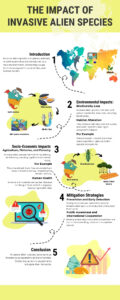The excessive and indiscriminate mining of sand has significantly greater ecological costs than advantages. Talk about the significance of sustainable sand mining in this setting. (Answer in 150 words)
Environmental Impacts: Invasive alien species compete with native species for resources, reducing biodiversity. They change habitats, nutrient cycles, and water systems, which can lead to ecosystem collapse. Example: Zebra mussels in North American waterways block pipes, push out native mussels, andRead more
- Environmental Impacts:
- Invasive alien species compete with native species for resources, reducing biodiversity.
- They change habitats, nutrient cycles, and water systems, which can lead to ecosystem collapse.
- Example: Zebra mussels in North American waterways block pipes, push out native mussels, and alter aquatic ecosystems.
- Socio-Economic Impacts:
- Invasive alien species harm farming, fishing, and forestry, causing significant economic losses.
- Example: The emerald ash borer has destroyed ash trees in North America, leading to losses in the timber industry and higher costs for removing and replacing trees.
- Invasive alien species can spread diseases and allergens, affecting human health.
- Example: The Asian tiger mosquito carries diseases like dengue fever and chikungunya, increasing health risks and public health costs.
- Mitigation Strategies:
- Strong prevention, early detection, and quick response strategies are needed.
- Raising public awareness and working together internationally are crucial for controlling the spread of invasive alien species.



Under the Mines and Minerals (Development and Regulation) Act, 1957 (MMDR Act), sand is a minor mineral. Main sources of sand are agricultural fields, riverbeds and floodplains, coastal and marine sand, lakes and reservoirs. Sand mining is done for use in the construction sector and to extract minerRead more
Under the Mines and Minerals (Development and Regulation) Act, 1957 (MMDR Act), sand is a minor mineral. Main sources of sand are agricultural fields, riverbeds and floodplains, coastal and marine sand, lakes and reservoirs. Sand mining is done for use in the construction sector and to extract minerals such as Rutile, Ilmenite and Zircon which contain useful elements Titanium and Zirconium. Sand is used in making glass, ceramics, silicon chips, solar panels, detergents, toothpastes etc.
According to the United Nations Environment Programme (UNEP), sand, along with gravels, are the most extracted minerals-accounting for 69-85% of the minerals mined every year. Further, the construction sector has grown at a fast rate because of rapid urbanization and infrastructure growth and government initiatives like Housing for All. Thus, the demand for sand is increasing every year leading to excessive as well as indiscriminate and illegal mining of sand.
Adverse impact of excessive sand mining can be seen in following ways:
Sand mining, when done at an optimum level, removes excessive sediment deposit in rivers. However, unscientific sand mining depletes river minerals at rates which the river system cannot replenish. Excessive mining undermines the ability of riverbeds and riverbanks to support the infrastructure built on them.
In this context, sustainable sand mining can help ecology in following ways:
Therefore, to ensure sustainable sand mining, the Government of India has launched a Sand Mining Framework to ensure sustainable sand mining practices. Imported sand is also being promoted as an alternative to excessive sand mining.
See less